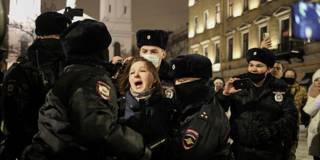The protests in Russia spurred by the arrest of opposition leader Alexei Navalny have drawn comparisons to the popular movement that emerged in Belarus last August after a fraudulent presidential election. But the differences between the two cases are more important than the similarities.
WARSAW – The biggest wave of protests in years has swept Russia, raising hopes that popular pressure will persist and intensify, gradually eroding an autocratic regime, as is happening in neighboring Belarus. But we should be wary of allowing the two countries’ similarities – which include history and language, religion and repression – to obscure profound differences.
In Belarus, protests erupted in August 2020, after President Aleksandr Lukashenko – Europe’s longest-serving leader – rigged yet another election, supposedly beating his opponent, Svetlana Tikhanovskaya, in a landslide. In Russia, the spark was the arrest of opposition leader Alexei Navalny upon his return to Russia after recovering from what was almost certainly a Kremlin-ordered poisoning. The protests strengthened after Navalny was hastily sentenced to nearly three years in a prison colony.
But that is where the similarities end. For starters, Navalny is not nearly as popular in Russia as outside observers seem to believe. Western media reported Navalny’s arrival in Moscow with the same excitement that accompanied Russian Nobel laureate Aleksandr Solzhenitsyn’s return to his homeland 27 years ago. Among Russians, however, Navalny’s approval rating is just 5%, according to the Levada Center, Russia’s only independent polling agency.

WARSAW – The biggest wave of protests in years has swept Russia, raising hopes that popular pressure will persist and intensify, gradually eroding an autocratic regime, as is happening in neighboring Belarus. But we should be wary of allowing the two countries’ similarities – which include history and language, religion and repression – to obscure profound differences.
In Belarus, protests erupted in August 2020, after President Aleksandr Lukashenko – Europe’s longest-serving leader – rigged yet another election, supposedly beating his opponent, Svetlana Tikhanovskaya, in a landslide. In Russia, the spark was the arrest of opposition leader Alexei Navalny upon his return to Russia after recovering from what was almost certainly a Kremlin-ordered poisoning. The protests strengthened after Navalny was hastily sentenced to nearly three years in a prison colony.
But that is where the similarities end. For starters, Navalny is not nearly as popular in Russia as outside observers seem to believe. Western media reported Navalny’s arrival in Moscow with the same excitement that accompanied Russian Nobel laureate Aleksandr Solzhenitsyn’s return to his homeland 27 years ago. Among Russians, however, Navalny’s approval rating is just 5%, according to the Levada Center, Russia’s only independent polling agency.